
Back Tríduum Pasqual Catalan Velikonoční triduum Czech Triduum Sacrum German Triduo Pascual Spanish Pazko Hirurrena Basque Triduum sacrum Finnish Triduum pascal French Vazmeno trodnevlje Croatian Trihari Suci ID Triduo pasquale Italian


| Liturgical seasons |
|---|
|
The Paschal Triduum or Easter Triduum (Latin: Triduum Paschale),[1] Holy Triduum (Latin: Triduum Sacrum), or the Three Days,[2] is the period of three days that begins with the liturgy on the evening of Maundy Thursday,[3] reaches its high point in the Easter Vigil, and closes with evening prayer on Easter Sunday.[4] It is a moveable observance recalling the Passion, Crucifixion, Death, burial, and Resurrection of Jesus, as portrayed in the canonical Gospels.[5]
In the Anglican, Lutheran, Methodist, Moravian and Reformed traditions, the Paschal Triduum straddles the two liturgical seasons of Lent and Easter in the Church calendar (Holy Saturday is the last day of Lent, with the Easter Vigil being the first liturgy of Eastertide). In the Roman Catholic tradition since the 1955 reform by Pope Pius XII, the Easter Triduum has been more clearly distinguished as a separate liturgical period.
Previously, all these celebrations were advanced by more than twelve hours. The Mass of the Lord's Supper and the Easter Vigil were celebrated on the morning of Thursday and Saturday respectively, and Holy Week and Lent were seen as ending only on the approach of Easter. In the Roman Rite, after the Gloria in excelsis Deo in the Mass of the Lord's Supper, all church bells are silenced (sometimes replaced by a crotalus) and the organ is not used. This period that lasted from Thursday morning to before Easter Sunday began what was once referred to in Anglo-Saxon times as "the still days".[6] Weddings in the Catholic Church were once prohibited throughout Lent and certain other times of the year as well,[7] and are still forbidden during the Triduum. Lutherans still discourage weddings during the entirety of Holy Week, inclusive of the Easter Triduum.
- ^ For the etymology of the term Paschal see Names of Easter.
- ^ "The Three Days: Maundy Thursday, Good Friday, and the Vigil of Easter". Evangelical Lutheran Church in America. 2012. Retrieved 1 April 2012.
- ^ "Catholic Liturgy, Holy Thursday Evening Mass of the Lord's Supper". Archived from the original on 4 April 2014. Retrieved 16 April 2009.
- ^ "General Norms for the Liturgical Year and the Calendar, 19". Archived from the original on 11 April 2009. Retrieved 16 April 2009.
- ^ Laughlin, Corrina (October 2018). Glory in the Cross: A Journey through the Paschal Triduum. Liturgy Training Publications. ISBN 9781616714925. Retrieved 4 February 2021.
- ^ Herbermann, Charles, ed. (1913). . Catholic Encyclopedia. New York: Robert Appleton Company.
- ^ Herbermann, Charles, ed. (1913). . Catholic Encyclopedia. New York: Robert Appleton Company.